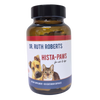Inspired by human health research, grounded in ethical pet care.
We all know exercise is good for us, but have you ever wondered how much it could transform your dog’s daily life too? A few simple changes to your routine can boost your dog’s energy, mood, and long-term wellbeing more than most pet parents realize. If you’ve ever felt your dog could use a little more structure, fun, or movement in their day, this guide will show you easy ways to make every walk, play session, and evening routine more meaningful.
What We Know About Exercise and Health
In human health research, regular physical activity is strongly associated with long-term wellness. A large 2025 study by the National Cancer Institute (NCI) and UK Biobank found that adults with the highest levels of daily movement had about a 26% lower risk of developing cancer compared with the least-active individuals. Mechanistic studies suggest that exercise may help regulate hormones, reduce inflammation, support immune function, and improve overall metabolism, factors that may contribute to a healthier internal environment.
With so much evidence pointing to the value of daily movement in humans, it’s natural to ask: “If exercise is so beneficial for us, what can it do for my dog?” While there are no studies showing that exercise reduces cancer risk in dogs, research does highlight meaningful health benefits tied to regular activity. For example, a 2020 study published in BMC Veterinary Research found that veterinary-prescribed physical activity improved movement levels and supported healthier body condition in previously under-active dogs.
We do, however, agree on one clear fact: daily, age-appropriate movement plays a major role in a dog’s overall health and quality of life. Maintaining a healthy weight, building muscle strength, supporting joint mobility, lowering stress, and providing mental enrichment are all powerful benefits your dog can gain from consistent activity.
Below, you’ll find safe, simple ways to build a well-rounded exercise routine for your dog—morning, afternoon, and evening.
Morning: Start the Day With Purposeful Movement
Walk or Jog: A quick bathroom stroll isn’t enough to meet most dogs’ activity needs. In the morning, aim for a walk that gets your dog’s body working, not just wandering. Begin the day with a brisk 20-30 minute walk or jog. This helps burn off excess energy and sets a positive tone for the day. If your dog is more active, consider incorporating some light jogging or playtime at a park.
Try these morning movement boosters:
-
Choose routes with hills or inclines
-
Gradually increase walk duration over time
-
Slowly increase walking pace as your dog gets fitter
-
Add short jogging intervals if appropriate for your dog’s age and health
If you live near a beach, walking on sand offers a gentle challenge and can help burn extra energy. Always monitor your dog for signs of fatigue, especially in warmer weather.
Mental Stimulation: After the walk, engage your dog with a short training session or puzzle toys. This not only stimulates their mind but also reinforces good behavior
Afternoon: Midday Play
Interactive Play: Spend 15-20 minutes playing fetch, tug-of-war, or any other interactive game your dog enjoys. This keeps them engaged and helps break up the day, especially if they're home alone for long periods. If your schedule allows, use a few minutes of your lunch break for quick, fun activities:
-
Indoor or backyard fetch
-
Tug-of-war
-
Nose work or hide-and-seek
-
A short, energetic walk
Socialization: If possible, arrange a playdate with another dog. Social interactions are crucial for emotional health and can help reduce anxiety
On hot days, keep movement indoors and use toys or puzzle feeders to provide enrichment without risking overheating. During winter, your dog may also need a modified routine, shorter outdoor sessions, protective gear like jackets or booties, and more indoor play can help maintain activity levels without exposing them to extreme cold.
For more warm-weather guidance, check out our full list of outdoor dog safety tips to keep your pup protected during hikes, walks, and hot-weather playtime. If you're looking for creative ways to keep your dog moving during the colder months, you may enjoy our guide on pet-friendly winter activities that help pets stay active and healthy even when it's freezing outside.
Evening: Restorative Activities
Evenings are ideal for slower, more intentional activities that help your dog release leftover energy and transition into a peaceful night. This part of the day is perfect for strengthening your bond, supporting emotional wellbeing, and giving your dog a comforting routine to look forward to.
-
Leisurely Walk
A gentle 15–20 minute walk in the evening can help your dog unwind and settle down for the night. The cooler temperatures make it more comfortable, and the calm atmosphere allows both of you to decompress from the day. This is also a great time for training touch-ups, mindful walking, and quiet bonding.
-
Calm Activities at Home
Create a soothing end-of-day routine with comforting activities, such as gentle petting, brushing, or a light massage. These calm interactions help ease tension, reduce stress, and deepen your connection. Many dogs find routine touch-based bonding incredibly grounding after an active day.
-
Low-Impact Playtime
If your dog still has a bit of energy, engage them with low-impact indoor games—like slow-paced fetch down a hallway, puzzle toys, snuffle mats, or easy scent-work exercises. These activities provide mental enrichment without overstimulation before bedtime.
-
Wind-Down Rituals
Establishing a predictable evening ritual can help signal to your dog that it’s time to relax. Soft music, dim lighting, a cozy resting spot, or a before-bed chew (like a safe dental chew or lick mat) can make this transition smoother and more comforting.
Use Technology to Track Your Dog’s Activity
Today’s pet tech can help you understand how active your dog really is. Health device or canine activity trackers monitor:
-
Daily steps
-
Playtime
-
Sleep patterns
-
Calorie burn
While these tools don’t diagnose health issues, they offer valuable insight and help you set realistic fitness goals for your dog. Explore different options to find what suits your pet’s lifestyle.
Additional Tips: Keeping Your Dog’s Exercise Routine Safe and Supportive
Creating a healthy movement routine goes beyond scheduling activities, it also means paying attention to your dog’s unique needs and making adjustments as they grow, age, and change. Here are a few essential tips to help you keep your dog active in a safe, thoughtful way:
Adjust for Age and Health
Every dog is different, and their exercise needs vary widely depending on age, breed, and overall health. Puppies may require short bursts of activity with plenty of breaks, while adult dogs often thrive with longer sessions. Senior dogs or those with mobility issues may benefit from shorter, low-impact outings spread throughout the day. When in doubt, consult your veterinarian to ensure the routine matches your dog’s physical abilities. If your dog is older, recovering from injury, or needs a gentle mobility boost, you can also explore our guide on passive range of motion exercises for dogs to help support joint comfort and flexibility.
Monitor for Signs of Fatigue
Pay close attention to your dog’s body language during and after exercise. Signs of fatigue may include excessive panting, slowing down, limping, drooling, or reluctance to continue. If you notice any discomfort, shorten the activity, reduce intensity, or take a break. Your dog’s well-being comes first, and adjusting the routine based on their energy levels helps prevent overexertion.
Prioritize Consistency Over Intensity
A little activity each day is more valuable than occasional intense workouts. Aim for regular, manageable movement that fits naturally into your routine and feels enjoyable for your dog.
Stay Flexible with Weather and Seasons
Hot weather, cold temperatures, rain, and snow can all affect your dog’s comfort and safety. Be prepared to modify activities, choosing indoor play, shorter walks, or alternative low-impact exercises during extreme conditions.
A Healthy Routine Is a Happy Routine
While movement offers powerful benefits for your dog’s weight, mobility, and emotional wellbeing, it’s important not to confuse these advantages with cancer treatment or prevention. Exercise can help support overall health, but it cannot cure or reduce cancer risk. Still, a thoughtful routine, paired with comfort, nutrition, and veterinary guidance, can help your dog feel their best each day.
If your dog is currently facing a cancer diagnosis, you’re not alone. Many pet parents want to know how to gently support their dog’s strength, appetite, and comfort during this time. Simple steps like shorter, low-impact walks, calm enrichment activities, and listening closely to your dog’s energy levels can make a meaningful difference in their daily quality of life.
For additional guidance, you may find these resources helpful:
-
Nutrition Support: Learn how a low-methionine diet may help support dogs with cancer and why pet parents are talking about it.
-
Video Guidance: Watch Dr. Ruth’s compassionate video, My Pet Has Cancer. Now What?, where she shares practical steps for supporting your pet holistically.
Every dog’s journey is unique, but with informed choices, gentle routines, and supportive care, you can help your pet feel more comfortable, connected, and loved—every step of the way.
















